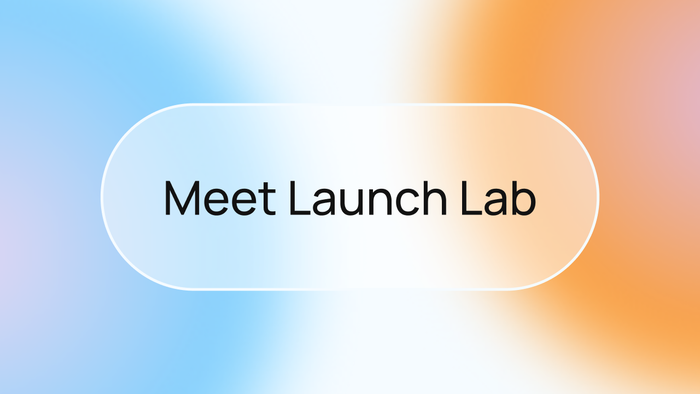No-code development platforms like Bubble let you create apps without needing to know how to code. These tools are perfect for founders making market-ready apps, companies needing custom internal tools, hobbyists working on pet projects, and more.
But with so many no-code app development platforms available in 2025, it’s hard to know which one is best for your needs. We recently conducted a thorough review with objective scoring metrics for all the major no-code platforms, and in this article, we’re summarizing the results for the top 10, including the pros and cons for each.
But first, let’s take a brief look at how no-code works.
What are no-code tools?
No-code tools use a visual interface for developing software with logic rather than coding. The specifics of how they work vary across different platforms, but generally speaking, they allow users to build out at least one of every application’s three main components: design, data, and logic.
- Design means how your app looks — the pages, buttons, and other visuals. No-code tools typically enable design through a drag-and-drop interface that lets you place different elements where you want them, as they’d appear in the final product. Most offer templates, and some have more advanced AI features that can handle the design for you.
- Data refers to the information your software stores and references to perform its functions, like user login details. Most full-stack no-code tools provide an easy way to interact with this data via data types and fields.
- Logic controls how your app reacts when someone uses it, like what happens when they click a button. A true no-code solution lets you build this logic with no coding at all, often through a collection of visualized if/then statements, while a low-code solution minimizes coding, but still requires some level of coding experience.
A full-stack no-code platform like Bubble includes all three elements of design, data, and logic. On the other hand, many of the platforms we’ll examine in this article include only two of the three, meaning you’ll have to add on an additional service to create a fully functional app.
No-code vs. low-code
The difference between no-code and low-code platforms is subtle, and classifying a given platform can sometimes be subjective. Low-code tools are easier than traditional development, but they still require some amount of coding. No-code platforms never require coding, though some allow for optional coding at the user’s preference.
In this list, you’ll find examples of both no-code and low-code platforms, and we’ll explain why each one qualifies as either.
How we scored and ranked these tools
To make our list of the top 10 platforms, we started with a survey of more than 350 no-code developers, the results of which we published in our 2024 State of No-Code Development Report. Respondents rated the importance of different factors that affect their decisions when choosing a no-code development platform. Based on those responses, we created a five-point scoring system that grades no-code app builders on each of the factors respondents identified as most important:
- Overall score
- Use-case versatility
- Full-stack coverage
- Performance
- Ecosystem quality
- Cost
- Customizability
- Compliance
- Code ownership
- Learning curve
- Education and documentation
- Community
We then graded every major no-code platform, giving them a score between 1 and 5 (with 5 being the best) based on how well they perform on each factor. From there, we gave each platform an overall score as a weighted average of the different factors, prioritized according to how the survey respondents ranked them. The higher respondents ranked a given factor, the more it contributed to the overall score.
In this article, we’re taking a look at the major pros and cons of the top ten no-code development platforms based on this scoring system. For a much more in-depth analysis of how each tool performed on each factor, check out our no-code buyer’s guide.
The top 3 no-code tools: 2025’s shortlist
Short on time? Here’s an at-a-glance overview of the three no-code solutions that most stand out from the rest. Scroll a little further for the full examination of all ten.
- Bubble is the overall best no-code development platform, allowing you to build anything. As a full-stack solution, it provides everything you need in one place. It’s easy to get started with and powerful enough to make whatever you need.
- Webflow doesn’t include a data solution and is best suited for website creation, but it’s a strong contender for web development that gains an edge with the ability to export your code.
- Wix is a powerful platform that is similarly optimized for website development, but it’s best suited for more technical users.
The 10 best no-code platforms by overall score
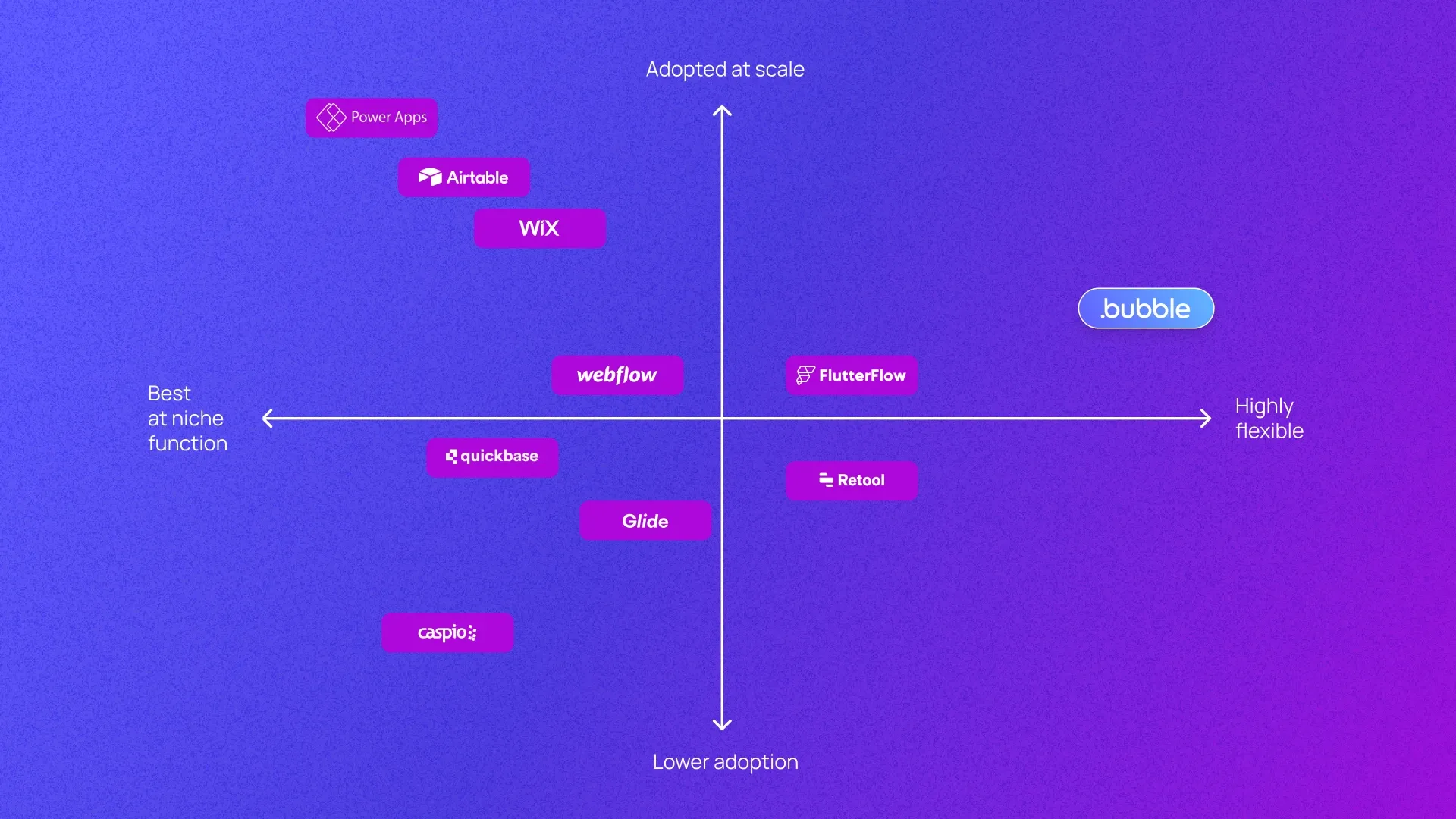
The top 10 no-code app development platforms in 2025 all bring something unique to the table. Here’s the full breakdown for each of them:
- Bubble (4.00)
- Webflow (3.89)
- Wix (3.89)
- Caspio (3.67)
- Power Apps (3.66)
- Glide (3.62)
- Quickbase (3.58)
- Retool (3.48)
- Airtable (3.45)
- FlutterFlow (3.43)
1. Bubble
No-code, full-stack, highly versatile
| Pros | Cons |
|---|---|
| Full-stack development: includes design, data, and logic in a single platform | Moderate learning curve |
| Coding is never required | No ability to export code |
| AI-powered design and custom build guides | |
| Thriving user community | |
| Extensive documentation and tutorials | |
| Robust third-party ecosystem |
Bubble is the full-stack, no-code app builder for everyone. With the highest score of any no-code platform (4.00), it places number one on the list. Bubble combines everything in one platform, letting you build apps from scratch without needing to code, no matter your experience. And while many other tools are best for a specific use case, Bubble is designed to let you build any applications and the websites to go along with them.
Bubble’s drag-and-drop visual editor helps you easily design the perfect user interface — or you can use Bubble's AI app generator to create a fully-functional app by writing a prompt in your own words. And for additional functionality, you can integrate any of the thousands of official and third-party plugins available on the Bubble Marketplace.
There is a bit of a learning curve when getting started, but you’ll have the support of a thriving user community found on places like the Bubble Forum and Facebook groups, extensive documentation including the Bubble Manual and numerous walk-through tutorials, and a responsive support team.
Bubble’s pricing is comparable to other high-end no-code builders, and offers different tiers depending on what you need. And unlike some no-code platforms, which charge you extra for AI features, they’re included in all of Bubble’s pricing plans at no extra cost.
- Free: $0/month
- Starter: $29/month
- Growth: $119/month
- Team: $349/month
- Enterprise: Contact Sales
Breakdown of Bubble’s score
Bubble has an overall score of 4.00. It excels at community, use-case versatility, full-stack coverage, and gets high marks for compliance, performance, customizability, and ecosystem quality.

Bottom line: Bubble is the best all-round no-code solution, providing everything needed to bring your vision to life on a single platform. It’s accessible enough for non-technical users, but flexible and robust enough to handle even the most complex of use cases.
2. Webflow
No-code, great for websites
| Pros | Cons |
|---|---|
| Complete code ownership with ability to export | Not a full-stack solution. Includes design and logic only |
| Thriving user community | Best for websites |
| Extensive documentation and tutorials | |
| Thriving user community | |
| Extensive documentation and tutorials | |
| Robust third-party ecosystem | |
| Security compliance with SOC 2 Type II and GDPR |
Webflow ties with Wix at 3.89 for a close second on the list. Like Bubble, Webflow offers a drag-and-drop editor for designing interfaces and lets you create app logic without coding. But Webflow isn’t a full-stack development platform, as it doesn’t include a data solution. You’ll have to look elsewhere for that.
Additionally, Webflow is best suited for building websites (like blogs or static landing pages). It becomes a lot more difficult to use when building apps with dynamic content (like marketplaces or AI-powered applications). So your experience with Webflow may vary depending on your use case.
AI capabilities are also more limited at the moment, though Webflow says they’re actively developing new AI features. For now, you can access an in-platform AI assistant that essentially serves as a chatbot to offer support.
Webflow is easy to start with but harder to use for complex apps. While the platform itself is no-code, integrating their plugins often does require coding, adding a barrier many users won’t want to deal with. But Webflow is one of only a few no-code platforms that allow users to export their code in its entirety.
Pricing for Webflow is on the lower end initially, but keep in mind that it doesn’t include a database management system, so you’ll have to pay another service for that.
- Free: $0/month
- Basic: $14/month
- CMS: $23/month
- Business: $39+/month
- Enterprise: Contact sales
Breakdown of Webflow’s score
Webflow has an overall score of 3.89. It excels at code ownership, ecosystem quality, education and documentation, and community, and it gets high marks for compliance and learning curve.
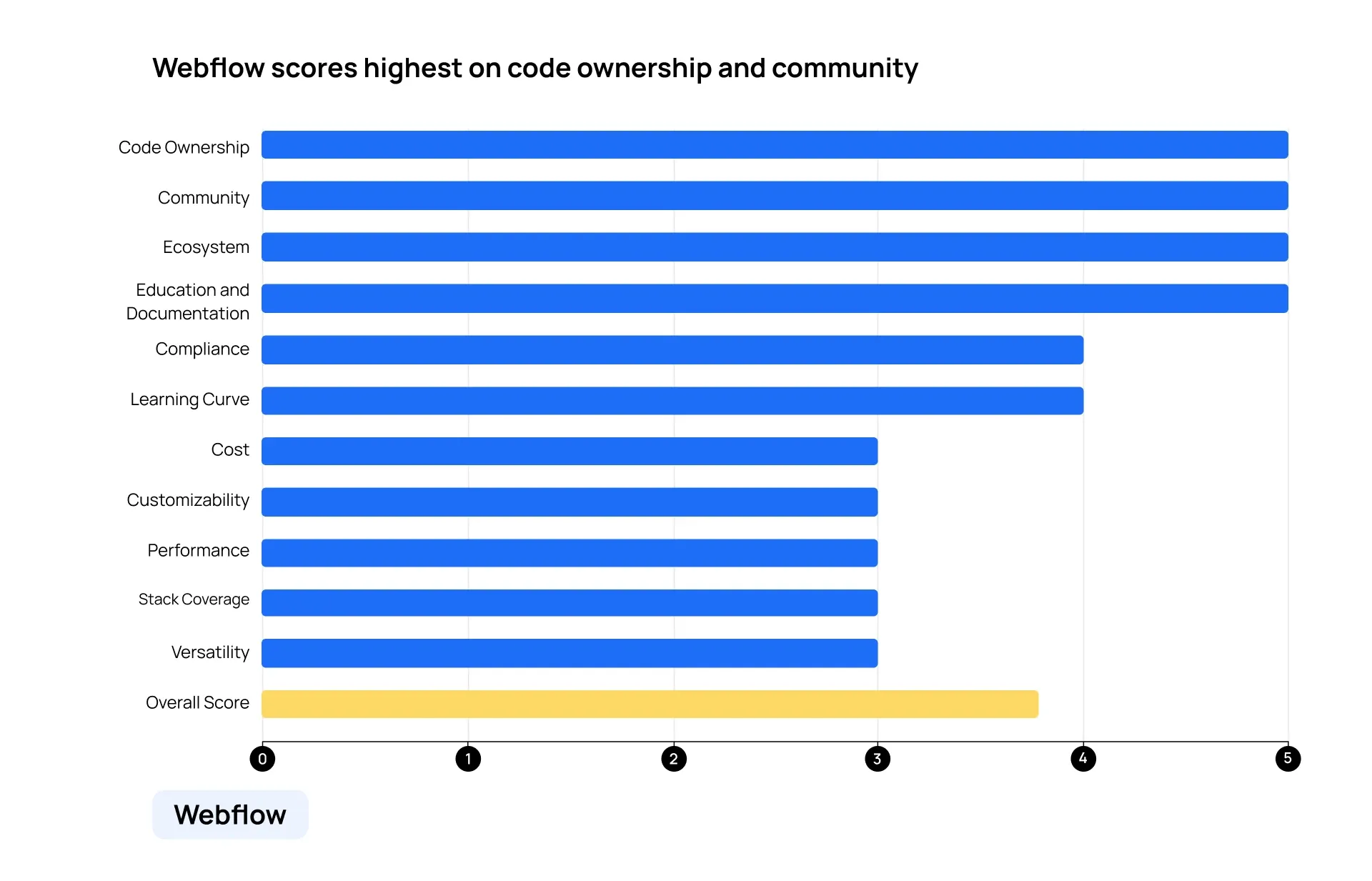
Bottom line: Webflow is a good no-code platform for building websites, and it’s a strong contender if you need the ability to export your code.
3. Wix
Low-code, highly customizable
| Pros | Cons |
|---|---|
| Extremely flexible. Users can build anything, but only if they know how to code | More low-code than no-code |
| Extensive documentation and tutorials | No ownership of code or ability to export |
| Robust third-party ecosystem | |
| Thriving user community | |
| Thriving user community | |
| Security compliance with SOC 2 Type II, ISO, GDPR, and CCPA |
Wix also has a score of 3.89, making it another strong contender. But, strictly speaking, Wix is closer to a low-code platform than a no-code one. To create anything beyond a basic site with Wix, you’ll need some coding skills. And much like Webflow, Wix is really best suited to websites, not apps.
It also has a greater learning curve than most other options, so you should really have some coding experience before using it.
Wix comes with a strong library of support materials and tutorials, a large and active user community, and a third-party ecosystem that includes templates, plugins, and integrations.
Pricing for Wix is fairly average, offering a range of options for your specific needs.
- Light: $17/month
- Core: $29/month
- Business: $36/month
- Business Elite: $159/month
- Enterprise: Contact sales
Breakdown of Wix’s score
Wix has an overall score of 3.89. It excels at compliance, customizability, ecosystem quality, education and documentation, and community. It suffers most in use-case versatility.
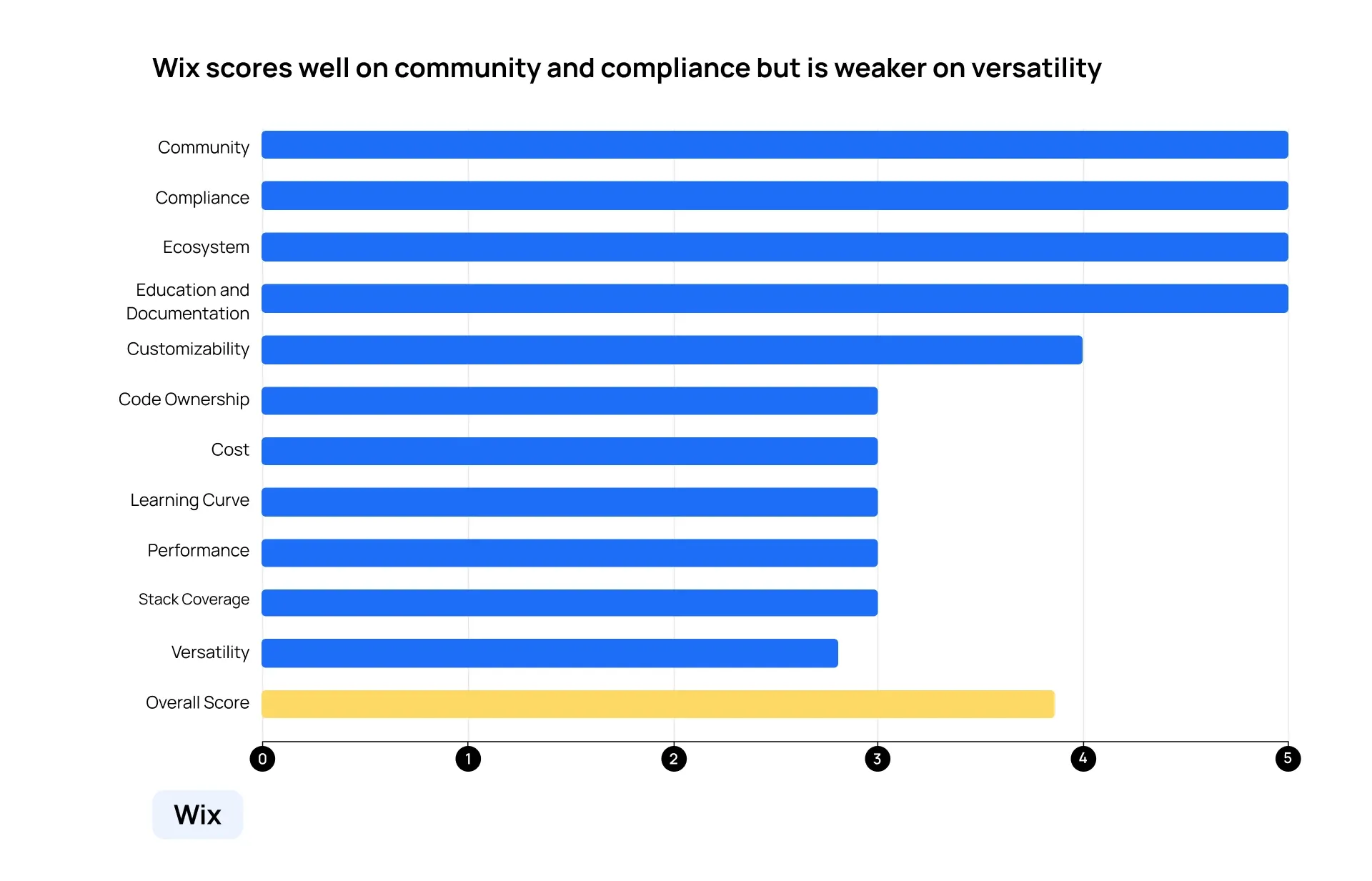
Bottom line: Wix is a good choice for websites if you’re willing and able to do some coding, but you should look elsewhere if you need a truly no-code solution.
4. Caspio
No-code, full-stack, allows full code and data exports
| Pros | Cons |
|---|---|
| A full-stack solution | Quite expensive |
| Good uptime and transparency | Fairly steep learning curve |
| Robust third-party ecosystem | Less active user community than most |
| Good documentation and tutorials | |
| Security compliance with SOC 2 Type II, ISO, GDPR, and CCPA |
Caspio, with an overall score of 3.67, sits somewhere between a no-code and a low-code solution. (Their website describes their solution as both, depending on which page you look at.) It qualifies as no-code, but you may need coding skills if you’re looking to build anything besides a simple app. It also has a steep learning curve and less community support compared to other platforms.
The primary use case for Caspio is building internal tools, and it works well in this area. But users may struggle when trying to build other kinds of applications.
Caspio is one of the few full-stack solutions available, including data, logic, and design in a single platform. And it has a good record of uptime, while providing transparency about their few outages.
Pricing for Caspio is on the more expensive side.
- Starter: $90/month
- Professional: $540/month
- Enterprise: $2,025/month
Breakdown of Caspio’s score
Caspio has an overall score of 3.67. It excels at code ownership, compliance, and full-stack coverage, and it gets high marks for performance, ecosystem quality, and education and documentation. It suffers most in the areas of cost and learning curve.
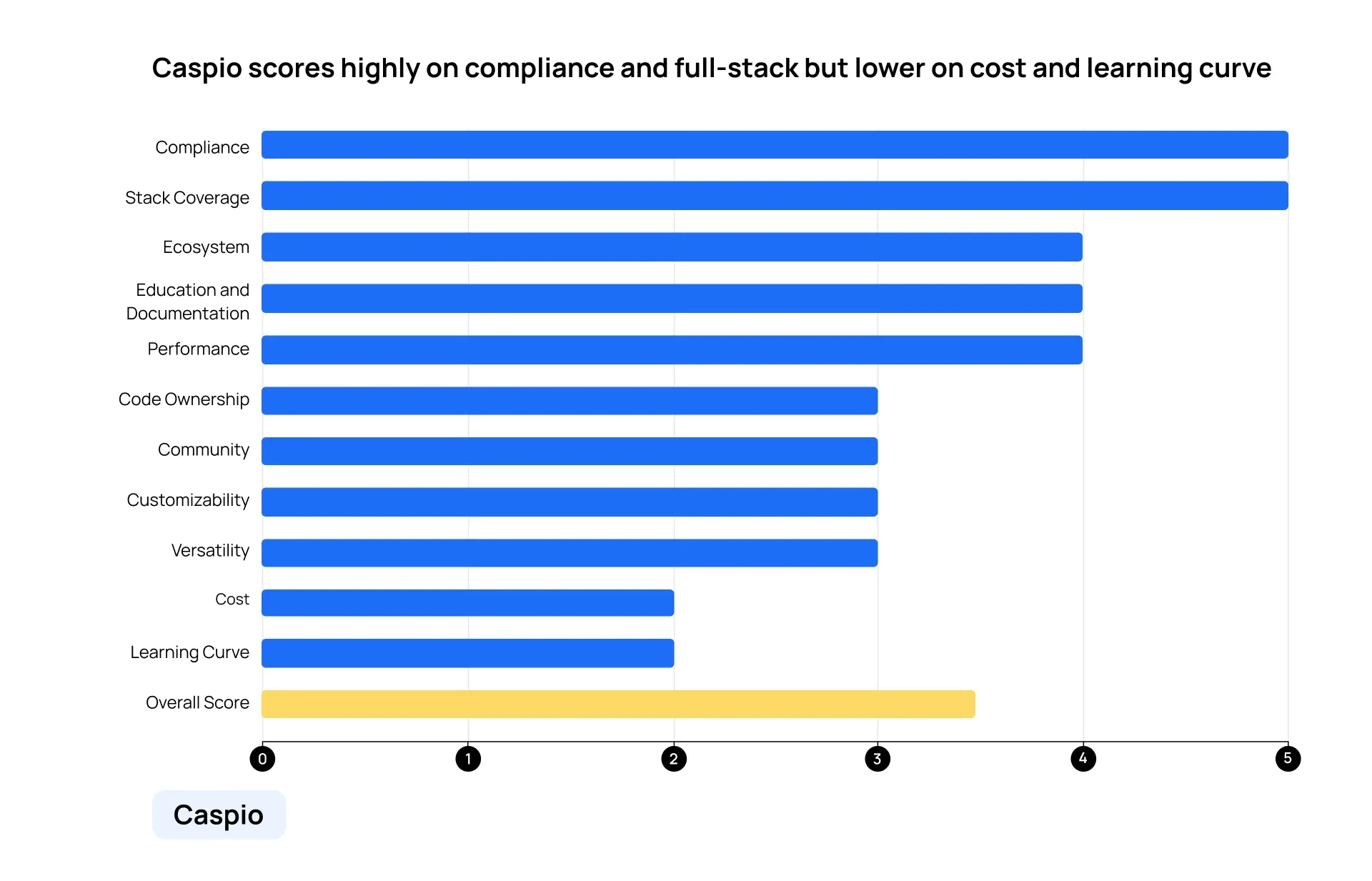
Bottom line: Caspio is best for more technical users who are building internal tools for their organization. If that’s you, it could be a good fit.
5. Power Apps
Low-code, Microsoft-native, allows full code and data exports
| Pros | Cons |
|---|---|
| Part of the Microsoft ecosystem | Not a full-stack solution. Includes design and logic only |
| Full code ownership with ability to export | Steep learning curve |
| Good uptime | Limited to internal business apps |
| Thriving user community | |
| Extensive documentation and tutorials | |
| Security compliance with SOC 2 Type II |
Power Apps, Microsoft’s low-code development platform, received a score of 3.66. As part of Microsoft’s Power Platform, it’s directly tied to their broader ecosystem. This could be a good or bad thing, depending on what you’re already using.
Power Apps is low-code, not no-code, so you’ll need some coding abilities. But you do get full code ownership and the ability to export as needed. To use Power Apps, you’ll need to learn Microsoft’s formula language, Power Fx, which many users find overly complicated. Power Apps comes with an extensive library of support materials and a thriving user community to help you out.
Power Apps isn’t a full-stack solution — it only includes design and logic, which means you’ll have to look elsewhere for a data solution. And it’s best for building business tools but limited for other types of apps.
Pricing for Power Apps is simpler than most, with a free option and a premium plan that decreases in price once you cross a user threshold. Since it doesn’t include a data solution, you’ll have to pay another service for that.
- Developer Plan: $0/month
- Premium (up to 2,000 users): $20/user/month
- Premium (2,000+ users): $12/user/month
Breakdown of Power Apps’ score
Power Apps has an overall score of 3.66. It excels at code ownership, performance, and education and documentation, and it gets high marks for compliance, ecosystem quality, and community. It suffers most in the areas of learning curve and customizability.
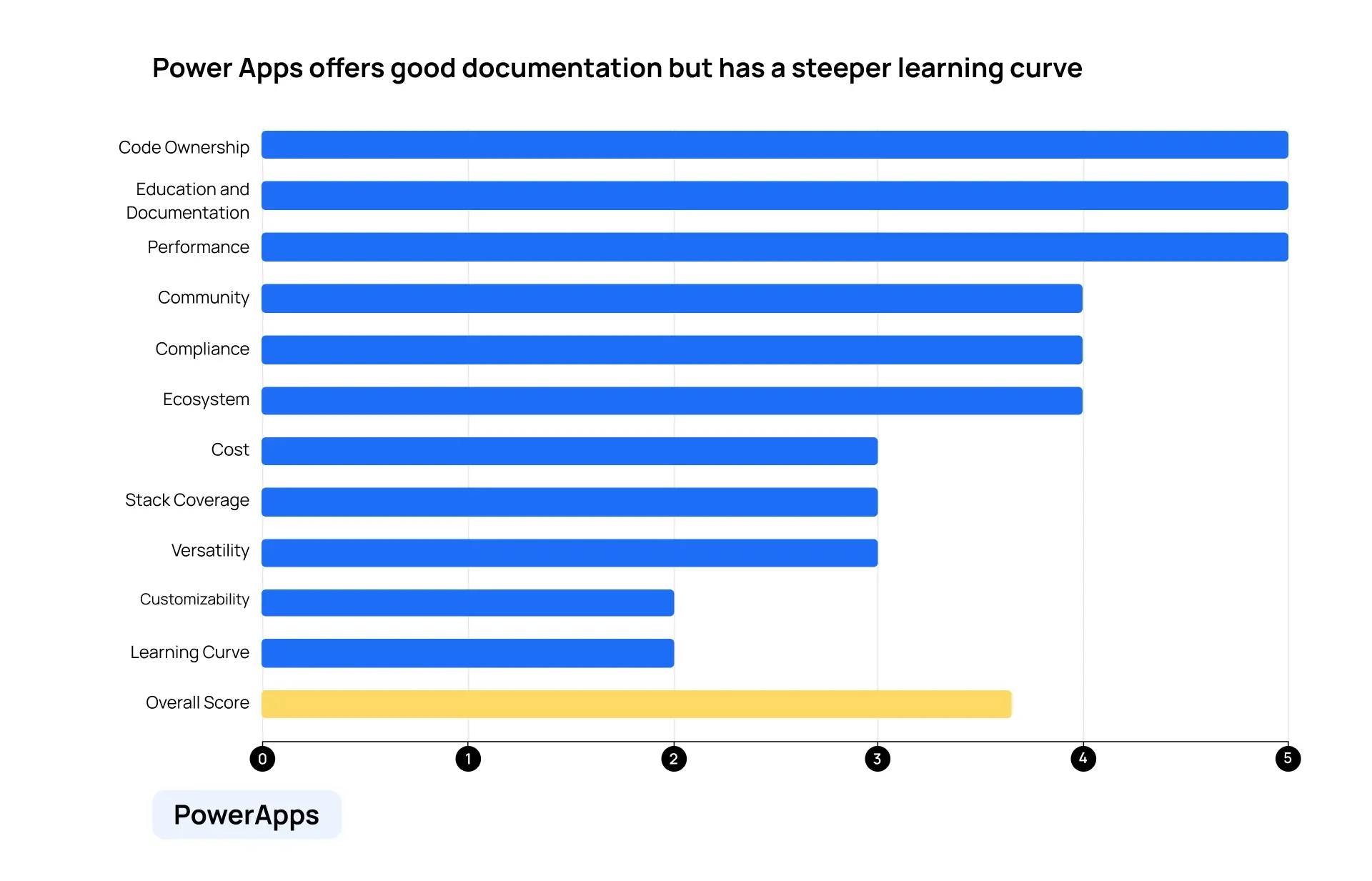
Bottom line: If you’re willing to learn a new coding language, and if you’re already using programs within Microsoft’s ecosystem, then Power Apps could be a good choice.
6. Glide
No-code, full-stack, great internal tool builder
| Pros | Cons |
|---|---|
| A full-stack solution | Unable to export code |
| Fairly minimal learning curve | Limited room for customization |
| Good documentation and tutorials | Easy to get started, but harder to build something robust |
| Strong user community | |
| Security compliance with SOC 2 Type II and GDPR | |
| Security compliance with SOC 2 Type II |
Glide has a score of 3.62. It’s a no-code development platform that initially relied on Google Sheets integration. These days, they prioritize their own Glide Tables for data (making them a full-stack solution), while continuing to support integration with Google Sheets and other external data solutions.
Glide is one of the easiest no-code platforms to start with, offering clear guides, templates, and training materials. Glide also offers some AI tools to enhance app creation.
Creating complex apps with Glide can be harder, and it has fewer plugins available. But Glide has a strong and active user base on their dedicated community page.
Pricing for Glide is divided into two cheaper plans for individual makers and three more expensive plans for companies.
- Free: $0/month
- Maker: $49/month
- Team: $99/month
- Business: $249/month
- Enterprise: $499/month
Breakdown of Glide’s score
Glide has an overall score of 3.62. It excels at full-stack coverage, and it gets high marks for performance, learning curve, education and documentation, community, and use-case versatility.
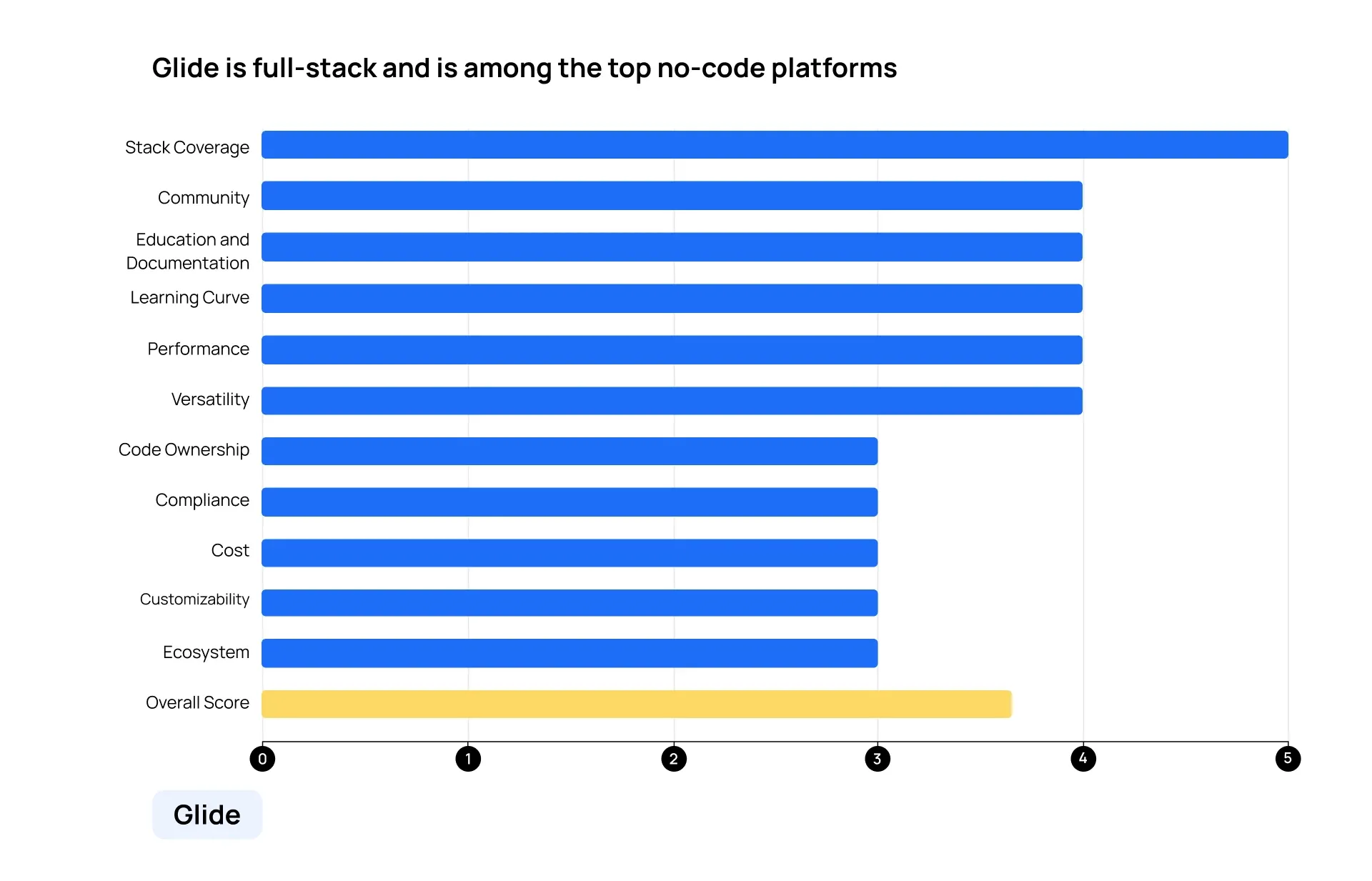
Bottom line: Glide is a solid entry point into no-code development, with one of the gentlest learning curves. But it’s best suited for basic apps without a lot of customization.
7. Quickbase
Low-code, great for building project management tools
| Pros | Cons |
|---|---|
| A full-stack solution | Low-code, but not no-code |
| Ability to export code | Very steep learning curve |
| Good uptime with transparency | Not flexible for anything other than project management tools |
| Fairly active user community | Less robust third-party ecosystem than most |
| Security compliance with SOC 2 Type II and HIPAA | Less extensive documentation than most |
| Expensive |
Quickbase, with a score of 3.58, is a bit of a rarity as a full-stack solution that also allows users to export their code. However, Quickbase is a low-code development platform, not no-code.
Quickbase works best for creating project management tools, which is great if that’s what you need. But using Quickbase to build anything else will be more difficult than on most other platforms.
It has a steep learning curve, with less documentation to get you up to speed. But it does have an active user community to help you out. It doesn’t have a particularly robust ecosystem of third-party plugins.
Quickbase’s pricing seems low at a glance, but their plans are all priced per-user, with a minimum of 20 or 40 users depending on the plan. That adds up quickly, making Quickbase one of the more expensive options and putting it likely out of reach for founders, individual developers, and small teams.
- Free trial (30 days only)
- Team: $35/user/month (min 20 users for $700/month)
- Business: $55/user/month (min 40 users for $2,200/month)
- Enterprise: Contact sales
Breakdown of Quickbase’s score
Quickbase has an overall score of 3.58. It excels at code ownership, compliance, performance, and full-stack coverage, and it gets high marks for community and use-case versatility. It suffers most in the areas of learning curve, customizability, and cost.
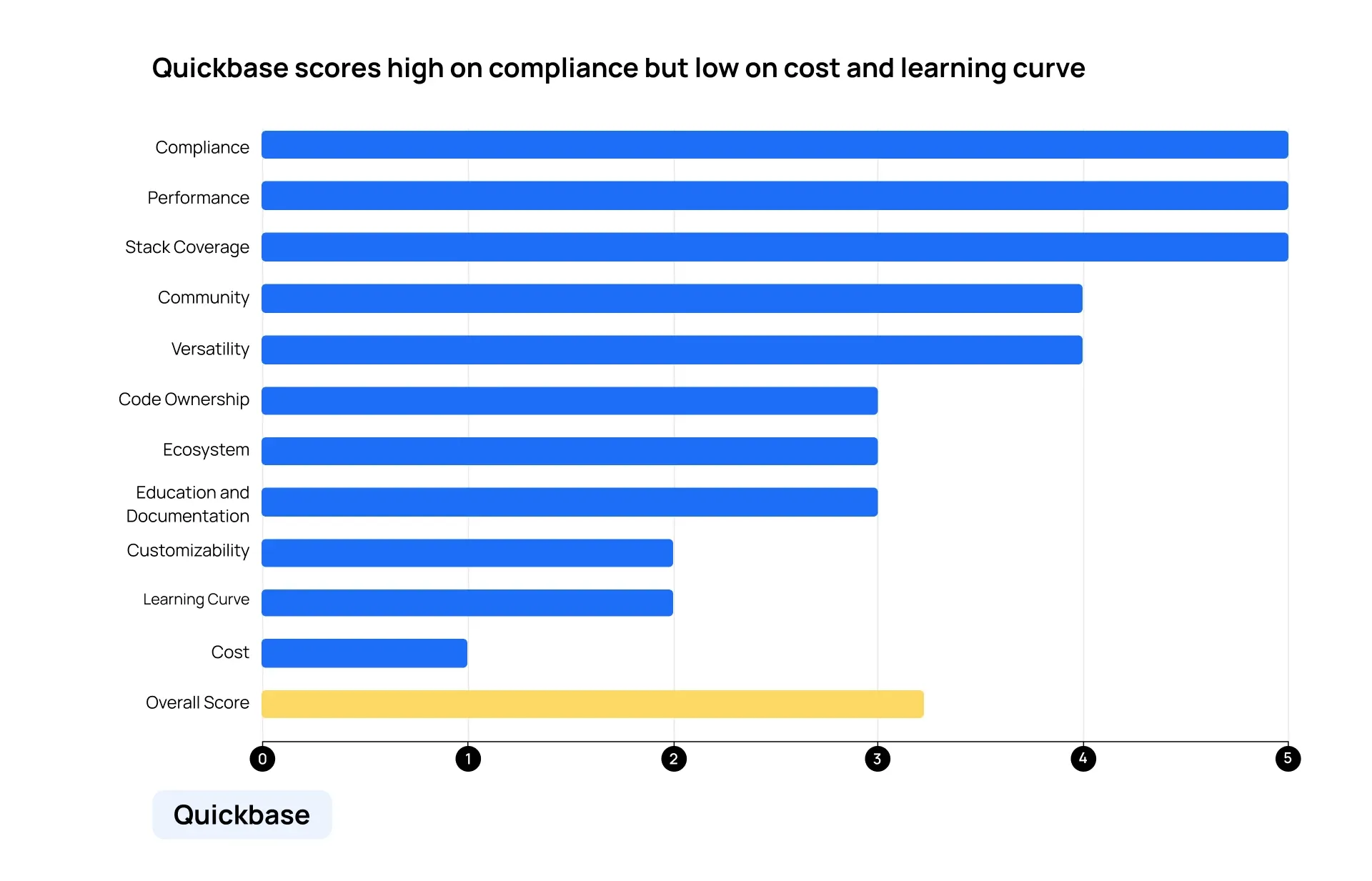
Bottom line: Quickbase’s pricing structure makes it prohibitively expensive for many, and the learning curve is steep, but it could be a good fit for large organizations needing custom project management tools.
8. Retool
Low-code, allows full code exports, great internal tool builder
| Pros | Cons |
|---|---|
| Full code ownership with ability to export | Low-code, but not no-code |
| Good uptime with transparency | Steep learning curve |
| Thriving user community | Mostly limited to corporate internal tools |
| Security compliance with SOC 2 Type II and CCPA | Not a full-stack solution. Includes design and logic only |
With a score of 3.48, Retool is another platform that offers low-code development, but not truly no-code development. It has a steep learning curve and works best for users with some coding experience. It isn’t a full-stack solution, so you’ll have to look elsewhere for data. It gives you full ownership of your code with the ability to export as a JSON file.
Retool’s active community is a great resource for support, and they have a decent number of templates and integrations to use. But those templates (and Retool in general) are best suited for corporate internal tools, like dashboards.
Pricing is a little more complicated than most, with separate charges for end users versus standard users. And since it doesn’t include a data solution, you’ll have to pay another service for that.
- Free: $0/month
- Team: $10/month/standard user + $5/month/end user
- Business: $50/month/standard user + $15/month/end user
- Enterprise: Contact sales
Breakdown of Retool’s score
Retool has an overall score of 3.48. It excels at code ownership and community, and it gets high marks for compliance and performance. It suffers most in its learning curve.
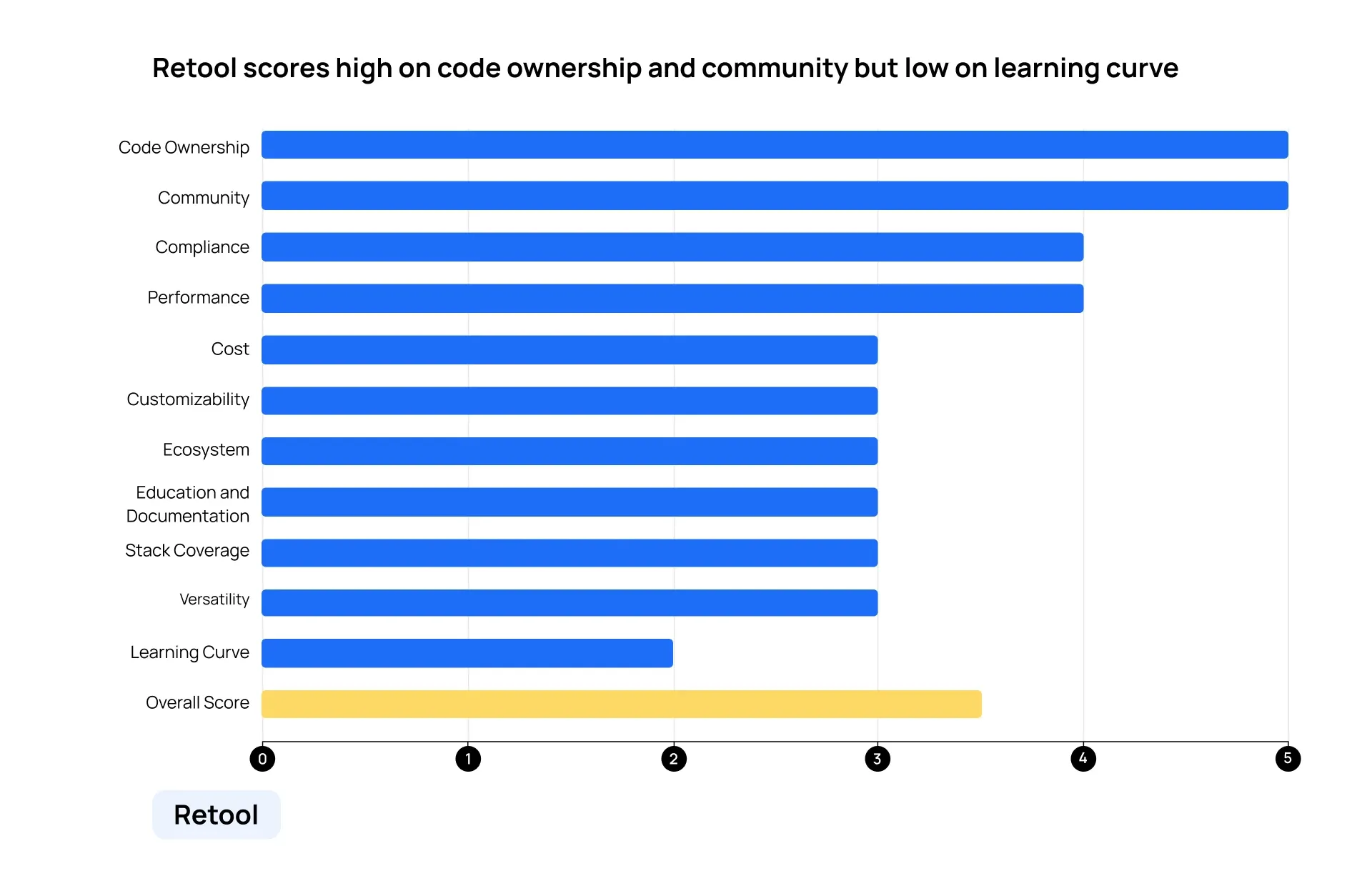
Bottom line: Retool is a viable solution for users building corporate internal tools who are willing and able to do some coding.
9. Airtable
No-code, great for building and managing a database
| Pros | Cons |
|---|---|
| Easy to get started | Moderate learning curve to make the most of it |
| Strong option for building databases | No ability to export code and only limited ability to export data |
| Robust third-party ecosystem | Fairly expensive |
| Extensive documentation and tutorials | AI capabilities cost extra |
| Security compliance with SOC 2 Type II, ISO 27001, HIPAA, GDPR, and CCCPA | Not a full-stack solution. Includes design and logic only |
Airtable received a score of 3.45. It’s a powerful database solution, meant to make working with databases as easy as working with spreadsheets. It includes no-code tools for adding logic to simple apps. But it doesn’t offer much customizable design, meaning it isn’t a full-stack solution.
Airtable is simple to use initially, with a bit of a learning curve to create more advanced apps. But that’s balanced out by their library of support materials. They also host third-party templates, plugins (which they call “apps”), and integrations. Airtable has some AI features, but they aren’t included by default.
Given its heavy focus on the database, Airtable is best suited for creating data-heavy project-management solutions.
Pricing for Airtable is on a per-seat basis, which means it can really add up depending on how many users you have. Additionally, no design is included, and their AI features are an additional charge.
- Free: $0/seat/month
- Team: $20/seat/month
- Business: $45/seat/month
- Enterprise: Contact sales
Breakdown of Airtable’s score
Airtable has an overall score of 3.45. It excels at compliance, ecosystem quality, and education and resources, and it gets a high mark for customizability. It suffers most in the areas of cost and code ownership.
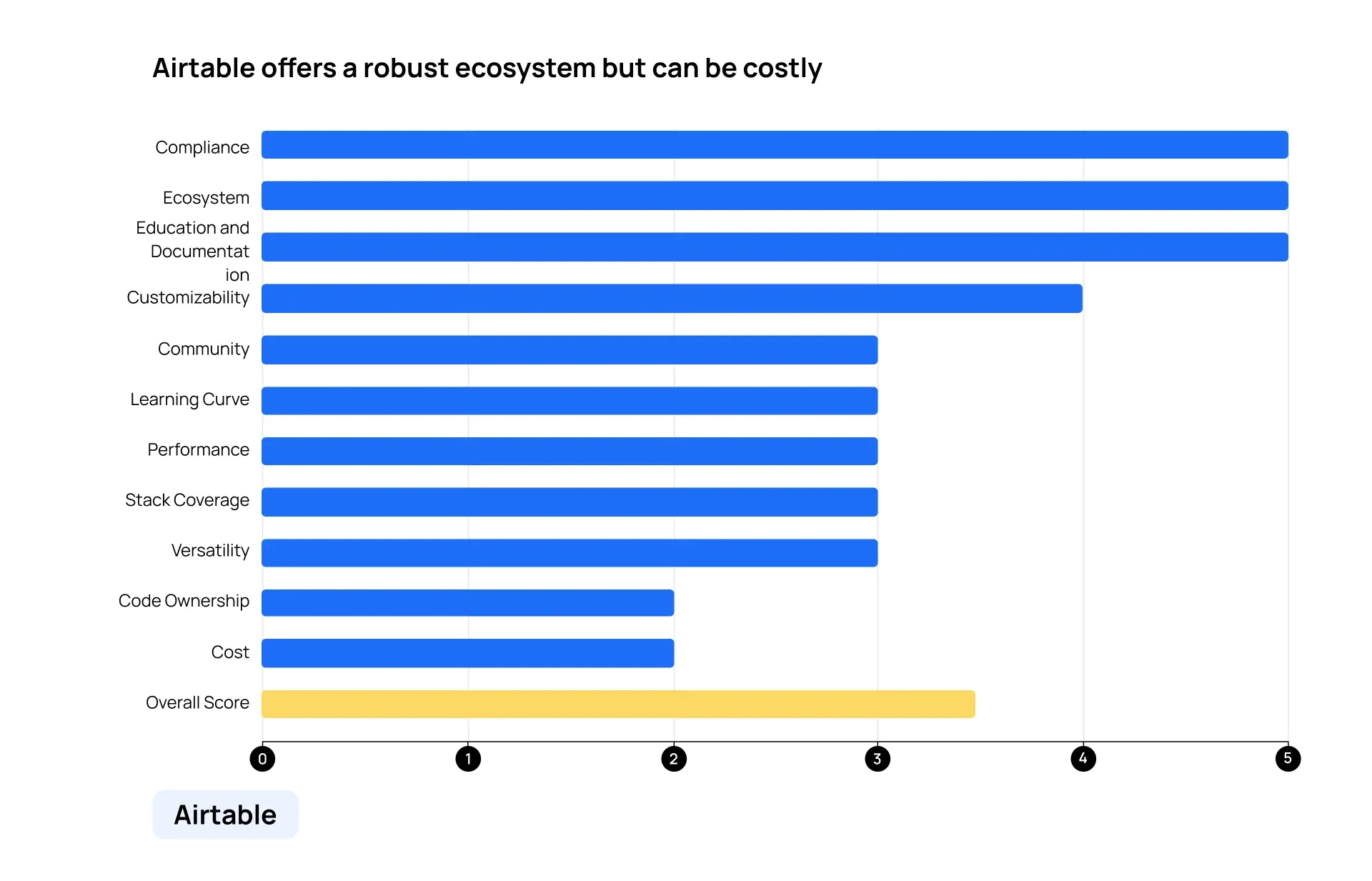
Bottom line: Airtable is a solid choice for those who primarily need an easy-to-use database solution.
10. FlutterFlow
No-code mobile app development, allows full code exports in Flutter code, excellent community
| Pros | Cons |
|---|---|
| Code can be exported | Code is exported as Flutter code, which can be difficult to work with |
| Extensive documentation and tutorials | Not much transparency into outages |
| Thriving user community | Moderate learning curve, some coding required |
| Security compliance with SOC 2 Type I | Fairly expensive |
FlutterFlow is a no-code mobile app development platform that uses Google’s Flutter framework, and it scored 3.42. Because it’s primarily intended for mobile apps, FlutterFlow doesn’t work well for developing web apps.
Although it doesn’t require coding for app logic, it does require some coding for setting up integrations, so be ready for at least a little contact with code. You’ll own the code for your Flutterflow apps, and you can export it — but only as Flutter code, which many users find difficult to work with.
It has a moderate learning curve that is slightly offset by Flutterflow’s high-quality training resources and tutorials, along with their active user base. Users with some technical skills can easily find the support they need.
FlutterFlow is a nearly full-stack solution in that it includes both design and logic and has good integration with Firebase for data. But Firebase will cost extra.
Most users find FlutterFlow to be easy to use for simple apps, but it requires a good bit more effort for building something complex.
Pricing for FlutterFlow ends up being more expensive than initially advertised, as you’ll have to pay for Firebase separately to use it. Plans include:
- Free: $0/month
- Standard: $30/month
- Pro: $70/month
- Teams: $70/user/month
- Enterprise: Contact sales
Breakdown of Flutterflow’s score
FlutterFlow has an overall score of 3.42. It excels at community, and gets high marks for code ownership, education and documentation, reputability, and full-stack coverage. It suffers most in the area of cost.
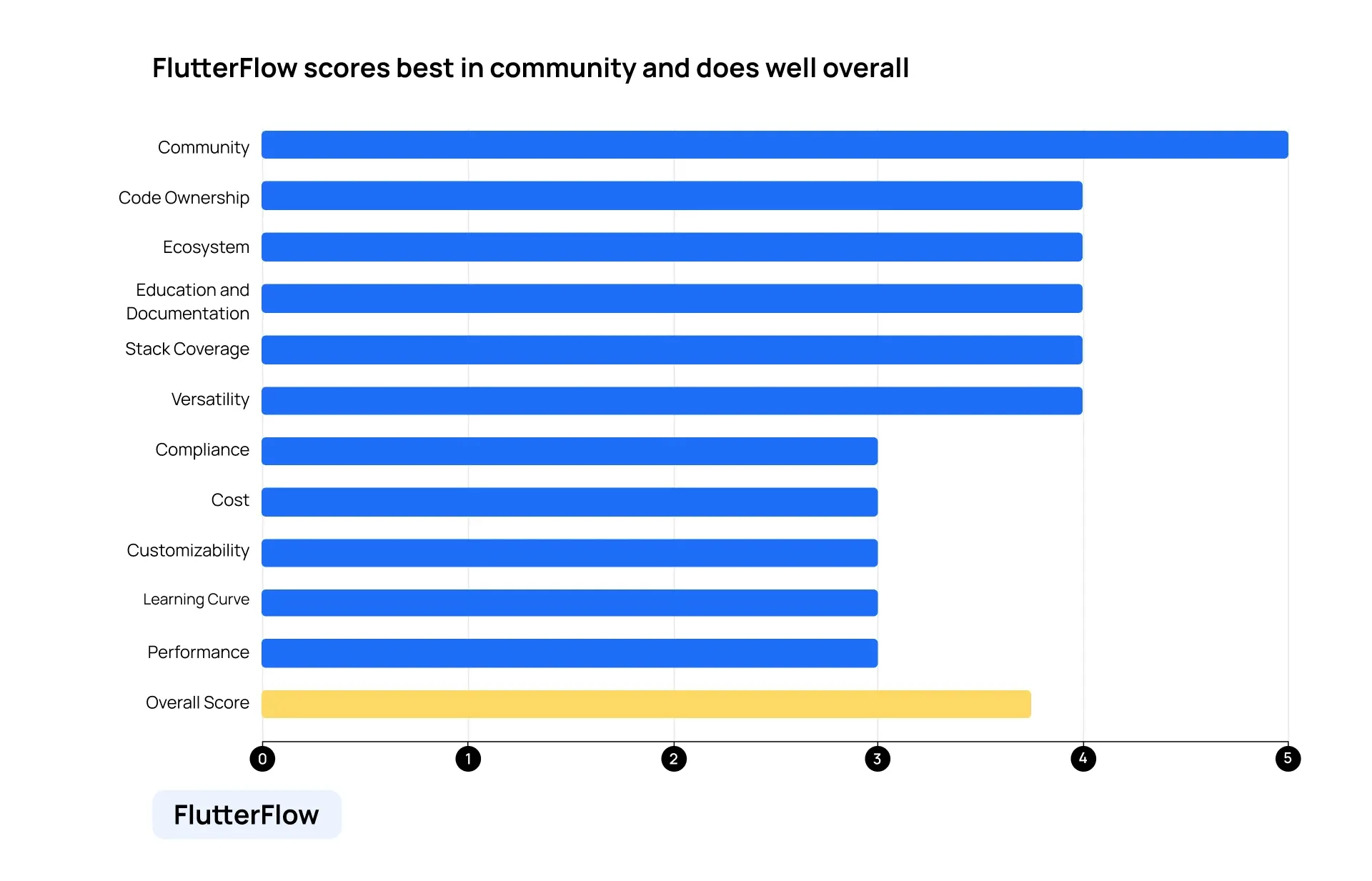
Bottom line: FlutterFlow is a good choice for developing mobile apps if you’re familiar with Flutter code and willing to work through a moderate learning curve.
Honorable mentions
These platforms didn’t quite make the top-10 list, but they’re popular enough to be worth considering. We’ll take a brief look at each.
Xano is a powerful low-code backend solution focused on data and API integrations, with some logic features. Many users of Bubble and other no-code platforms use Xano for their backend.
WordPress is more of a content management system than a no-code app builder. Still, it offers features that enable no-code app building.
Jotform is an easy-to-use and powerful form builder. It uses conditional logic to automate integrations with business tools. It’s best for simple productivity tools, not complex apps.
Betty Blocks is a low-code platform designed for enterprise apps. It’s easier to use than most low-code platforms but still harder than no-code tools. And it lacks design elements.
Adalo is a no-code app development platform focused on building mobile apps. It works well for very simple apps, but users tend to struggle when trying to build something more robust.
AppSheet is Google’s no-code development platform, built to integrate with Google Cloud. It’s best suited for users already invested in Google’s ecosystem.
Softr adds logic and design to existing spreadsheets or databases. It works well as a frontend tool for Airtable backends. But you’ll have to pay for both services separately.
Sharetribe is designed specifically for building custom marketplaces. It’s great for its intended use case but not for other types of apps.
Supabase is an open source database solution. It can be used as a low-code backend for app development, but it isn’t really a development platform.
Bildr is a no-code development platform with a steep learning curve. It has fewer educational materials than most, a small user community, and ticket-only support.
Thunkable is a no-code platform for mobile apps that lets you export APKs. It supports design and logic but relies on table-based data, which limits its capabilities.
Which is the right no-code platform for you?
Choosing the right no-code platform depends on what you need. In this article, we’ve covered the highlights and drawbacks of each to help you make that decision. For a closer look at the factors to consider when choosing an app builder (and to see how these tools and others compare on them), check out our no-code buyer’s guide.
If one of these solutions stood out to you as clearly the one most aligned with your use case, perfect! If not, then Bubble offers the best all-around experience to help you build whatever you want.
Bubble is a truly no-code solution, it’s full-stack, and it offers the power and flexibility to meet your needs, whatever those may be. And since it’s free to get started, you can try it out yourself before committing.
Start building with a free account.
Build for as long as you want on the Free plan. Only upgrade when you're ready to launch.
Join Bubble






